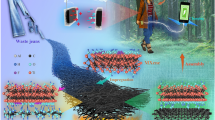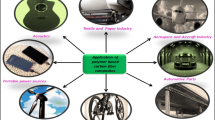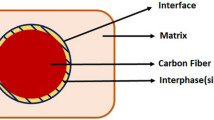Abstract
The development of high-frequency devices has attracted more research interest in electromagnetic wave–absorbing materials having lightweight, low filler content, thin thickness, minimum reflection loss and broad absorption bandwidth. Nevertheless, none of the materials uses steel waste (mill scale) as a potential low-cost catalyst to synthesize carbon nanotubes (CNT) as an electromagnetic (EM) wave absorber. Hence, multiwalled carbon nanotubes loaded in epoxy resin with an increasing polymer composite thickness of 1 mm, 2 mm, and 3 mm were introduced in this study. With varying milling times of mill scale (4 h, 20 h and 40 h) as catalyst, as-synthesized carbon nanotubes were produced using the chemical vapour deposition (CVD) method. Two main phases (carbon and iron carbide) were obtained from the synthesized carbon nanotubes. The samples’ morphology was mostly straight like, spiral, twisted carbon and spring pasta-like structures. The two-dimensional (2D) network structure of as-synthesized CNT loaded into epoxy resin, extends the transmission route of EM wave being absorbed. Moreover, the ratio of ID/IG is consistent at around 1.0 attributed to defective structure or a lower graphitization degree. In addition, higher electrical resistivity in the sample indicates wider separation between CNTs allowing for better EM wave absorption. The as-synthesized carbon nanotubes that are utilized as filler with lightweight properties, improved the reflection loss approach to − 25 dB (10.5 GHz) for growth CNT catalyzed by mill scale milled for 20 h loaded into polymer matrix (GM20h/P) at thickness of 3 mm. As the thickness of the polymer composites increased from 1 to 3 mm, all composite samples reflected a loss peak closer to a lower frequency range. The results demonstrated that the EM wave absorption ability was improved to 99.9% by using nanometer size mill scale waste as a catalyst to grow carbon nanotubes and further used as an EM wave absorber.
This is a preview of subscription content, to check access.








Similar content being viewed by others
References
Emerson WH (1973) Electromagnetic wave absorber and anechoic chambers through the years. IEEE Trans Antenn Propag 21(4):484–490. https://doi.org/10.1109/TAP.1973.1140517
Liu X (2010) Study on microwave absorbing behavior of multi-walled CNTs. Mod Appl Sci 4(9):124–129. https://doi.org/10.5539/mas.v4n9p124
Gao C, He X, Ye F, Wang S, Zang G (2021) Electromagnetic wave absorption and mechanical properties of CNTs@GN@Fe3O4/PU multilayer composite foam. Materials 14 (23) 7244, 1–16. https://doi.org/10.3390/ma14237244
Qi XS, Yang Y, Zhong W, Deng Y, Au C, Du Y (2009) Large-scale synthesis, characterization and microwave absorption properties of carbon nanotubes of different helicities. J Solid State Chem 182(10):2691–2697. https://doi.org/10.1016/j.jssc.2009.07.036
Ren F, Yu H, Wang L, Saleem M, Tian Z, Ren P (2014) Current progress on themodification of carbon nanotubes and their application in electromagnetic wave absorption. RSC Adv 4:14419–14431. https://doi.org/10.1039/C3RA46989A
Zhan Y, Xia L, Yang H, Zhou N, Ma G, Zhao T, Huang X, Xong L, Qin C, Guangwu W (2021) Tunable electromagnetic wave absorbing properties of carbon nanotubes/carbon fiber composites synthesized directly and rapidly via an innovative induction heating technique. Carbon 175:101–111. https://doi.org/10.1016/j.carbon.2020.12.080
Yanagi R, Segi T, Ito A, Ueno T, Hidaka K (2021) Carbon-nanotube-based ultralight materials for ultrabroadband electromagnetic wave shielding and absorption Jpn. J Appl Phys 60(8):087003. https://doi.org/10.35848/1347-4065/ac14a5
Li Q, Zhang Z, Qi L, Liao Q, Kang Z, Zhang Y (2019) Towards the application of high frequency electromagnetic wave absorption by carbon nanostructures. Avanced Science 6(8) 1801057 1–23. https://doi.org/10.1002/advs.201801057
Volder MD, Tawfick S, Baughman R, Hart A (2013) Carbon nanotubes: present and future commercial applications. Science 339(6119):535–539. https://doi.org/10.1126/science.1222453
Liu C, Fan Y, Liu M, Cong H, Cheng H, Dresselhaus MS (1999) Hydrogen storage in single-walled carbon nanotubes at room temperature. Science 286(5442):1127–1129. https://doi.org/10.1126/science.286.5442.1127
González M, Crespo M, Baselgaa J, Pozuelo J (2016) Carbon nanotubes scaffolds with controlled porosity as electromagnetic absorbing materials in the gigahertz range. Nanoscale 8(20):10724–10730. https://doi.org/10.1039/c6nr02133f
Novoselov KS, Geim AK, Morozov SV, Jiang D, Katsnelson MI, Grigorieva IV, Dubonos SV, Firsov AA (2005) Two dimensional gas of massless Dirac fermions in graphene. Nature 438(7065):197–200. https://doi.org/10.1038/nature04233
Geim AK (2009) Graphene: status and prospects. Science 324(5934):1530–1534. https://doi.org/10.1126/science.1158877
Zhu Y, Murali S, Cai W, Li X, Suk J, Potts JR, Ruoff RS (2010) Graphene and graphene oxide: synthesis, properties and applications. Adv Mater 22:3906–3924. https://doi.org/10.1002/adma.201001068
Liu J, Rinzler AG, Dai H, Hafner J, Bradley RK, Boul PJ, Lu A, Iverson T, Shelimov K, Huffman CB, Macias FR, Shon YS, Lee TR, Colbert DT, Smalley RE (1998) Fullerene pipes. Science 280(5367):1253–1256. https://doi.org/10.1126/science.280.5367.1253
Lin Y, Zhao F, Wu Y, Chen K, Xia Y, Li G, Prasad SKK, Zhu J, Huo L, Bin H, Zhang Z, Guo X, Zhang M, Sun Y, Gao F, Wei Z, Ma W, Wang C, Hodgkiss J, Bo Z, Inganäs O, Li Y, Zhan X (2017) Mapping polymer donors toward high-efficiency fullerene free organic solar cells. Adv Mater 29:1604155. https://doi.org/10.1002/adma.201604155
Guo C, Li C (2011) A self-assembled hierarchical nanostructure comprising carbon spheres and graphene nanosheets for enhanced supercapacitor performance. Energy Environ Sci 4(11):4504–4507. https://doi.org/10.1039/C1EE01676H
Bottari G, Torre GDL, Guldi DM, Torres T (2010) Covalent and noncovalent phtalocyanine-carbon nanostructure systems: synthesis, photoinduced electron transfer, and application to molecular photovoltaics. Chem Rev 110:6768. https://doi.org/10.1021/cr900254z
Zhao Y, Wu W, Li J, Xu Z, Guan L (2014) Encapsulating MWNTs into hollow porous carbon nanotubes: a tube-in-tube carbon nanostructure for high-performance lithium-sulfur batteries. Adv Mater 26:5113. https://doi.org/10.1002/adma.201401191
Dai H (2002) Carbon nanotubes: synthesis, integration, and properties. Acc Chem Res 35(12):1035–1044. https://doi.org/10.1021/ar0101640
Arepalli S (2004) Laser ablation process for single-walled carbon nanotube production. J Nanosci Nanotechnol 4(4):317–325. https://doi.org/10.1166/jnn.2004.072
Öncel C, Yürüm Y (2006) Carbon nanotube synthesis via the catalytic CVD method: a review on the effect of reaction parameters. Fullerenes, Nanotubes, and Carbon Nonstructures 14:17–37. https://doi.org/10.1080/15363830500538441
Danafar F, Fakhru’l-Razi A, Salleh MAM, Biak DRA, (2009) Fluidized bed catalytic chemical vapor deposition synthesis of carbon nanotubes—a review. Chem Eng J 155(1–2):37–48. https://doi.org/10.1016/j.cej.2009.07.052
Kumar M, Ando Y (2010) Chemical vapor deposition of carbon nanotubes: a review on growth mechanism and mass production. J Nanosci Nanotechnol 10(6):3739–3758. https://doi.org/10.1166/jnn.2010.2939
Tessonnier JP, Su DS (2011) Recent progress on the growth mechanism of carbon nanotubes: a review. Chemsuschem 4(7):824–847. https://doi.org/10.1002/cssc.201100175
Prasek J, Drbohlavova J, Chomoucka J, Hubalek J, Jasek O, Adam V, Kizek R (2011) Methods for carbon nanotubes synthesis—review. J Mater Chem 21(40):15872–15884. https://doi.org/10.1039/C1JM12254A
Journet C, Picher M, Jourdain V (2012) Carbon nanotube synthesis: from large-scale production to atom-by-atom growth. Nanotechnology 23(14):142001. https://doi.org/10.1088/0957-4484/23/14/142001
Idris FM, Kaco H, Shafie MSE (2019) Recycling and utilization of mill scale to produce current smart electromagnetic absorbing material, Innovation for sustainability and green technology: degradation of inanimate forms. Penerbit USIM, Malaysia
Oddershede J, Nielsen K, Stahl K (2007) Using X-ray powder diffraction and principal component analysis to determine structural properties for bulk samples of multiwall carbon nanotubes. Z Kristallogr 222(3–4):186–192. https://doi.org/10.1524/zkri.2007.222.3-4.186
Ryu H, Singh BK, Bartwal KS (2008) Synthesis and optimization of MWCNTs on Co-Ni/MgO by thermal CVD, Adv. Condens. Matter Phys. 971457-971462. https://doi.org/10.1155/2008/971457
Somiya S (2013) Handbook of advanced ceramics: materials, applications, processing, and properties. Elsevier, Netherlands
Belin T, Epron F (2005) Characterization methods of carbon nanotubes: a review. Mater Sci Eng B 119(2):105–118. https://doi.org/10.1016/j.mseb.2005.02.046
Lambin P, Loiseau A, Culot C, Biro LP (2002) Structure of carbon nanotubes probed by local and global probes. Carbon 40(10):1635–1648. https://doi.org/10.1016/S0008-6223(02)00006-4
Wang Z, Hui C (2003) Electron microscopy of nanotube. Springer, Berlin
Tessonnier JP, Rosenthal D, Hansen TW, Hess C, Schuster ME, Blume R, Girgsdies F, Pfander N, Timpe O, Su DS, Schlögl R (2009) Analysis of the structure and chemical properties of some commercial carbon nanostructures. Carbon 47(7):1779–1798. https://doi.org/10.1016/j.carbon.2009.02.032
Musso S, Giorcelli M, Pavese M, Bianco S, Rovere M, Tagliaferro A (2008) Improving macroscopic physical and mechanical properties of thick layers of aligned multiwall carbon nanotubes by annealing treatment. Diamond Relat Mater 17(4–5):542–547. https://doi.org/10.1016/j.diamond.2007.10.034
McCaldin S, Bououdina M, Grant DM, Walker GS (2006) The effect of processing conditions on carbon nanostructures formed on an iron-based catalyst. Carbon 44(11):2273–2280. https://doi.org/10.1016/j.carbon.2006.02.030
Dasa R, Hamid SBA, Alia ME, Ramakrishna S, Yongzhib W (2015) XRD pattern same as also being reported by carbon nanotubes characterization by X-ray powder diffraction – a review. Curr Nanosci 11(1):23–35. https://doi.org/10.2174/1573413710666140818210043
Pawlyta M, Łukowiec D, Danikiewicz ADD (2012) Characterisation of carbon nanotubes decorated with platinum nanoparticles. J Achievements in Mater Manufactur Eng 53(2):67–75
Motojima S, Hoshiya S, Hishikawa Y (2003) Electromagnetic wave absorption properties of carbon microcoils /PMMA composite beads in W bands. Carbon 41(13):2658–2660. https://doi.org/10.1016/S0008-6223(03)00292-6
Zhao DL, Shen ZM (2008) Preparation and microwave absorption properties of carbon nanocoils. Mater Lett 62(21–22):3704–3706. https://doi.org/10.1016/j.matlet.2008.04.032
Tang NJ, Zhong W, Au CT, Yang Y, Han MG, Lin KL, Du YWJ (2008) Synthesis, microwave electromagnetic, and microwave absorption properties of twin carbon nanocoils. Phys Chem C 112(49):19316–19323. https://doi.org/10.1021/jp808087n
Fejes D, Hernadi K (2010) A review of the properties and CVD synthesis of coiled carbon nanotubes. Materials 3(4):2618–2642. https://doi.org/10.3390/ma3042618
Dunlap BI (1992) Connecting carbon tubules. Phys Rev B 46(3):1933–1936. https://doi.org/10.1103/PhysRevB.46.1933
Dunlap BI (1994) Relating carbon tubules. Phys Rev B 49(8):5643–5650. https://doi.org/10.1103/PhysRevB.49.5643
Hikita M, Bradford RL, Lafdi K (2014) Growth and properties of carbon microcoils and nanocoils. University Crystals 4(4):466–489. https://doi.org/10.3390/cryst4040466
Chiu SC, Yu HC, Li YY (2010) High electromagnetic wave absorption performance of silicon carbide nanowires in the Gigahertz range. J Phys Chem C 114(4):1947–1952. https://doi.org/10.1021/jp905127t
Che BD, Nguyen BQ, Nguyen LTT, Nguyen HT, Nguyen VQ, Le TV, Nguyen NH (2015) The impact of different multi-walled carbon nanotubes on the X-band microwave absorption of their epoxy nanocomposites. Chem Cent J 9(10):1–13. https://doi.org/10.1186/s13065-015-0087-2
Qin F, Brosseau C (2012) A review and analysis of microwave absorption in polymer composites filled with carbonaceous particles. J Appl Phys 111(6):061301. https://doi.org/10.1063/1.3688435
Gojny FJ, Wichmann MHG, Fiedler B, Kinloch IA, Bauhofer W, Windle AH (2006) Evaluation and identification of electrical and thermal conduction mechanisms in carbon nanotube/epoxy composites. Polymer 47(6):2036–2045. https://doi.org/10.1016/j.polymer.2006.01.029
Zeng Y, Liu P, Du J, Zhao L, Ajayan PM, Cheng HM (2010) Increasing the electrical conductivity of carbon nanotube/polymer composites by using weak nanotube–polymer interactions. Carbon 48(12):3551–3558. https://doi.org/10.1016/j.carbon.2010.05.053
Aguilar JRQ, Avilés F (2010) Influence of carbon nanotube clustering on the electrical conductivity of polymer composite films. Express Polym Lett 4(5):292–299. https://doi.org/10.3144/expresspolymlett.2010.37
Sun X, He J, Li G, Tang J, Wang T, Guo Y, Xue H (2013) Laminated magnetic graphene with enhanced electromagnetic wave absorption properties. J Mater Chem C 1(4):765–777. https://doi.org/10.1039/C2TC00159D
Zhu H, Bai Y, Liu R, Lung N, Qi Y (2011) Microwave absorption properties of MWCNT-SiC composites synthesized via a low temperature induced reaction. J AIP Adv. 1 032140 (3) :1–7. https://doi.org/10.1063/1.3630126.
Kong L, Yin X, Zhang Y, Yuan X, Li Q, Ye F, Cheng L, Zhang L (2013) Electromagnetic wave absorption properties of reduced graphene oxide modified by maghemite colloidal nanoparticle clusters. J Phys Chem C 117(38):19701–19711. https://doi.org/10.1021/jp4058498
Hiura H, Ebbesen TW, Tanigaki K, Takahashi H (1993) Raman studies of carbon nanotubes. Chem Phys Lett 202(6):509–512. https://doi.org/10.1016/0009-2614(93)90040-8
Cheng J, Zhang X, Luo Z, Liu F, Ye YY, W, Liu W, Han Y, (2006) Carbon nanotube synthesis and parametric study using CaCO3 nanocrystals as catalyst support by CVD. Mater Chem Phys 95(1):5–11. https://doi.org/10.1016/j.matchemphys.2005.04.043
Cheng T, Fang Z, Zou G, Hu Q, Hu B, Yang X, Zhang Y (2006) A one-step single source route to carbon nanotubes. Bull Mater Sci 29(7):701–704
Hussein MZ, Zakarya SA, Sarijo SH, Zainal Z (2012) Parameter optimisation of carbon nanotubes synthesis via hexane decomposition over minerals generated from Anadara granosa shells as the catalyst support. J Nanomater 525616:1–9. https://doi.org/10.1155/2012/525616
Sun GB, Dong BX, Cao MH, Wei BQ, Hu CW (2011) Hierarchical dendrite-like magnetic materials of Fe3O4, gamma-Fe2O3, and Fe with high performance of microwave absorption. Chem Mater 23(6):1587–1593. https://doi.org/10.1021/cm103441u
Sun KJ, Wincheski RA, Park C (2008) Magnetic property measurements on single wall carbon nanotube polyimide composites. J Appl Phy 103(2). https://doi.org/10.1063/1.2832616
Wincheski B, Kim JW, Sauti G, Wainwright E, Williams P, Siochi EJ (2015) Nondestructive evaluation techniques for development and characterization of carbon nanotube based superstructures., 41st Annual review of progress in quantitative nondestructive evaluation, 34, 1–9. https://doi.org/10.1063/1.4914731
Olmedo L, Hourquebie P, Jousse F (1997) H.S. Nalwa (Ed.), Handbook of organic conductive molecules and polymers, John Wiley and Sons Ltd., Chichester.
Choudhary V, Gupta A (2011) Polymer / carbon nanotube nanocomposites, In Tech.
Barrau S, Demont P, Perez E, Peigney A, Laurent C, Lacabanne C (2003) Effect of palmitic acid on the electrical conductivity of carbon nanotubes-epoxy resin composites. Macromolecules 36(26):9678–9680. https://doi.org/10.1021/ma030399m
Brosseau C, Beroual A, Boudida A (2000) How do shape anisotropy and spatial orientation of the constituents affect the permittivity of dielectric heterostructures? J Appl Phys 88:7278–7288. https://doi.org/10.1063/1.1321779
Yazid AF, Mukhtar H, Nasir R, Mohshim DF (2022) Incorporating carbon nanotubes in nanocomposite mixed-matrix membranes for gas separation: a review. Membranes 12(589):1–20. https://doi.org/10.3390/membranes12060589
Gonzalez-Domínguez JM, Maser W, Benito A, et al. (2008) Carbon nanotubes dispersion towards polymer integration. NanoSpain2008, Braga, Portugal.
Inam F, Peijs T (2007) Re-agglomeration of carbon nanotubes in two-part epoxy system; influence of the concentration. Proceedings of the 5th International Bhurbhan Conference on Applied Science and Technology, Islamabad, Pakistan.
Michielssen E, Sajer JM, Ranjithan S, Mittra R (1993) Design of lightweight, broad-band microwave absorbers using genetic algorithms. IEEE Trans Microw Theory Tech 41(6):1024–1031. https://doi.org/10.1109/22.238519
Funding
The authors acknowledge the Ministry of Higher Education Malaysia for financial support through Fundamental Research Grant Scheme (FRGS/1/2020/STG05/USIM/02/3) (USIM/FRGS/KGI/KPT/52020) and Long-Term Research Grant Scheme (LRGS/B-U/2013/UPNM/Defence & Security-P2).
Author information
Authors and Affiliations
Corresponding author
Ethics declarations
Conflict of interest
The authors declare that there is no conflict of interests.
Additional information
Publisher's note
Springer Nature remains neutral with regard to jurisdictional claims in published maps and institutional affiliations.
Rights and permissions
Springer Nature or its licensor (e.g. a society or other partner) holds exclusive rights to this article under a publishing agreement with the author(s) or other rightsholder(s); author self-archiving of the accepted manuscript version of this article is solely governed by the terms of such publishing agreement and applicable law.
About this article
Cite this article
Mohd Idris, F., Amin Matori, K., Ismail, I. et al. Materials’ characterization and properties of multiwalled carbon nanotubes from industrial waste as electromagnetic wave absorber. J Nanopart Res 24, 244 (2022). https://doi.org/10.1007/s11051-022-05625-x
Received:
Accepted:
Published:
DOI: https://doi.org/10.1007/s11051-022-05625-x




